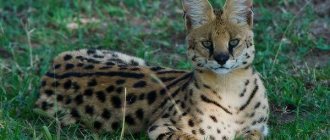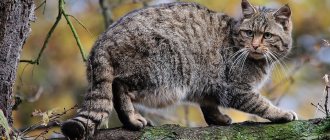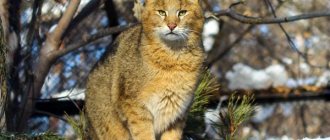Description of the appearance of the animal
- In its dimensions it is closer to a large cat. Weight does not exceed ten kilograms.
- The body is long, from 60 to 80 cm, elongated, flexible, muscular. The height at the withers reaches 35 cm.
- The paws are small and powerful.
- The tail is thin, proportional to the body, from 30 to 60 cm long.
- The fur is short, smooth, thick. A monochromatic color has no transitions or tonalities. Only on the chest and nose there may be lighter shades. Coat color varies from gray, bright red to brown and black.
- The head is small, slightly flattened with a round, short muzzle.
- The ears are small and rounded.
- The eyes are round, light brown with a tea tint.
- Vocal range: purring, screaming, whistling, chirping, chirping - more than thirteen different sounds.
Origin of the species and description
Jaguarundi is a carnivorous mammal belonging to the cat family. This animal is original in many of its manifestations. Outwardly, it has collected features belonging to several animals. The structure of the elongated body of the jaguarundi resembles predators belonging to the family of mustelids and civets.
It shows features of weasel and Madagascar fossa. Many claim that the rounded muzzle and rounded ears of this feline are very reminiscent of an otter. Others see in it signs of a puma and a jaguar at the same time.
Jaguarundi fur can be of the following colors: gray; deep red; brown. It was because of the differences in color that some time ago these predators were divided into two varieties: jaguarundi and air. Then scientists found out that these cats successfully mate with each other, giving birth to both red and gray kittens.
Thanks to this observation, the division of animals into two varieties was considered erroneous and the jaguarundi was classified as a member of the puma genus. Zoologists have identified seven subspecies of jaguarundi, discovered in different years. Outwardly, they are all identical and differ only in their places of permanent residence.
Scientists believe that jaguarundis were the first to be tamed by people in ancient times to protect food from rats and mice. Cats deftly dealt with not only rodents, but also reptiles and various insects that could harm humans.
In many Indian tribes, jaguarundis lived as pets. They were distinguished by their stern character and aggressive attitude towards strangers, and they carefully defended their owners and territory.
Habitats
The Jaguarundi is also called the South American cat, since its main habitat is South and Central America; the animal is found in Mexico, Texas, and Arizona. There are several subspecies of jaguarundi. Each of them lives in its own territory.
The cat's habitat is vast: subtropics, savanna, tropical rainforests and even mountains. A prerequisite for life is the presence of a reservoir and dense vegetation. They settle along the coasts of rivers and lakes, in wetlands, in thorny bushes and grass thickets. The jaguarundi's flexibility and body structure help it feel great in such a habitat. It is important for animals that other animals and people visit them as little as possible. In the mountains they climb to a height of 3000-3500 m above sea level.
Jaguarundi subspecies
The following subspecies of jaguarundi are known:
- Puma yagouaroundi ameghini - in western Argentina,
- Puma yagouaroundi cacomitli - in southern Texas and Mexico,
- Puma yagouaroundi eyra - Brazil, Paraguay, Argentina,
- Puma yagouaroundi fossata - in Mexico and Honduras,
- Puma yagouaroundi melantho - in Peru and Brazil,
- Puma yagouaroundi panamensis - from Nicaragua to Ecuador,
- Puma yagouaroundi tolteca - in Arizona and Mexico,
- Puma yagouaroundi yagouaroundi - in Guyana and the Amazon forests.
Lifestyle, habits
Under natural conditions, jaguarundis are shy loners leading a secretive lifestyle. Pairs and groups of animals can only be seen during the mating season. At home they become sociable, but only among family members.
INTERESTING! South American cats differ from other felines in their preference to be active during the day rather than at night. The climax of the hunt is noon. They hunt more often on the ground. But they can swim and climb trees if necessary. Therefore, they can catch fish or birds.
Being an excellent hunter, the predator is ready to pursue its prey over a long distance. During a hunt, it is able to freeze, standing on its hind legs and tracking down the game. He can remain in this position for a long time and wait for the moment convenient to attack. The cat attacks quickly and swiftly, so that the victim does not have time to come to his senses.
Jaguarundi, like all representatives of the cat family, mark their territory: they scratch the ground and trees, make “marks” with urine, and rub their heads and bodies against objects.
The animal competes with coyote, ocelot, fox, puma, and lynx.
The modest size of the animal forces it to be afraid of larger predators. In case of an unwanted encounter, the cat will prefer to hide in the thicket of the thicket. But if a skirmish is inevitable, the fight will be mortal, to the end: the jaguarundi is not used to being a coward.
Character and lifestyle
This cat is a loner by nature, secretive. Jaguarundi seeks the company of its own kind only for reproduction.
The male’s personal territory occupies up to 100 square meters. km, the territory of the female is smaller, up to 20 square meters. km. A male's territory may overlap with that of several females.
Jaguarundis also differ from other cats in that they are active during daylight hours. They climb trees well and are not afraid of water. But they prefer to live on earth.
They are ruthless towards their prey and can pursue the victim for a very long time. They can attack any living creature that is superior in strength.
Did you know? Jaguarundi is probably the only cat that can eat plant foods - bananas, grapes, and other fruits.
Nutrition
The basis of a predatory cat's diet is meat. Due to their modest size, their diet includes small game: hamsters, chinchillas, guinea pigs, rabbits. It feeds on small birds and fish, reptiles (small and medium-sized iguanas and lizards), frogs, and insects.
The cat also loves plant sweets: figs, dates, bananas, grapes.
Jaguarundi is not averse to visiting farmsteads and farms in order to destroy poultry houses, destroy animals with valuable fur, and destroy fruit and berry plantations. They become a real headache for farmers and are considered serious pests.
Jaguarundi nutrition
As previously mentioned, wild jaguarundi cats belong to the cat family and are predators. Their diet mainly consists of small mammals. For example, animals really like different birds, frogs, and fish that they manage to catch near the river bank.
These cats can eat rabbits, chinchillas and guinea pigs, as well as some other types of insects. Which of these mammals will become the main ones in the jaguarundi's diet is always determined by their habitat, because in different areas there are different animals that choose this particular habitat.
If you buy a jaguarundi, you must be fully prepared for the fact that you will have to provide it with a meat diet. Such an animal can destroy all domestic rabbits and birds, because despite its attachment to people, the natural instinct is completely preserved and food habits do not change.
Reproduction
Sexual maturity of females occurs at two to three years. Estrus lasts three to five days. The wild cat does not have a specific breeding season. In the tropics this is any time of year. In colder climates, mating occurs in March and September. The female can bear offspring every six months.
INTERESTING! During the mating season, males resemble our March cats: they scream loudly and fight.
The duration of pregnancy in females is 70-75 days. Babies are born in a secluded place prepared in advance by the mother. This could be a hollow tree or dense thickets of bushes and grass. There are usually one to four kittens in a litter.
For three weeks, kittens feed mainly on mother's milk, gradually getting used to adult food. After a month and a half, the small predators are already able to hunt on their own. But they will be able to live independently only after two years.
Breeding in captivity is not much different from breeding in the wild.
Who are Jaguarundi
According to Wikipedia, there are about 200 registered cat breeds in the world today. And how many species and breeds are currently being worked on, and have not yet received approval from international associations, is simply not known! But at the same time, a person wants something new, unusual, exotic. And then his gaze turns to the wild nature. This is how wild cats appear in our homes - manulas, servals, ocelots, karkkals. There were times when it was fashionable to keep cheetahs, snow leopards, and tigers. And now, a new candidate for pets has appeared. Meet the Jaguarundi!
Everything about this cat is amazing! Let's start with the appearance - a small head on a long neck, an unusually elongated body and short strong legs. It’s as if several animals were brought together in it - weasel, civet, otter... In fact, the closest relative of this beauty is the puma (cougar), which also reflects the species name of the animals - Puma yagouaroundi. An adult representative of the breed weighs 4 - 9 kg, with a height at the withers of 25 - 35 cm.
The next amazing fact is the color. It ranges from dark gray to bright red tones. Initially, it was believed that these were different species, but then they noticed that representatives of both colors perfectly create families and give healthy offspring. Moreover, the litter will contain kittens of all colors.
In the wild, jaguarundis are found throughout almost all of South America. Moreover, they are very unpretentious in choosing a territory - they can be found in the savannah, in swampy forests, and in the mountains. Thus, these animals are universal - they are excellent climbers, excellent swimmers, and they are also masters of camouflage. And so much so that they are still a little studied species.
These cats also eat a variety of foods. Depending on their habitat, their diet includes small animals, reptiles, fish, insects, and, surprisingly, fruits!
It is known that they were kept by local tribes from ancient times. But later they were abandoned. Despite the fact that cats were excellent rat catchers and helped preserve the harvest, when their owners were absent, they could not overcome their hunting instincts and ruined poultry houses.
By the way, this is still happening now, cats still visit the chicken coops of villagers, and even raid fruit plantations, teaming up with monkeys for this purpose. In zoos they are offered figs, bananas, and grapes.
And one more amazing point - unlike other savages, jaguarundi are very easily tamed and get used to people. Communication and mutual understanding between animals and humans is also facilitated by the fact that mini pumas are diurnal animals, while most cats are nocturnal. Their peak activity occurs at 11 o'clock in the afternoon.
The spectrum of sounds produced by the jaguarundi is also worth mentioning separately. In addition to the usual purring, their repertoire includes yapping, quiet growling, howling, whistling and even chirping, similar to a bird.
These animals adapt well to captivity, eat well and reproduce easily. However, they are completely unsuitable for apartment maintenance. But in a country house the cat will feel great. You just need to build her a good enclosure, with branches for climbing, scratching posts and secluded places to hide and sleep. By the way, even though jaguarundis are cats, they climb trees rather reluctantly and not very high.
The owners of these exotics note that, as always, when working with a predator, an important point in establishing a trusting relationship is feeding. If you feed a kitten from infancy, be affectionate and patient, you will get a gentle, obedient, intelligent and sociable cat. Energetic and playful. You just need to remember that the practice of domesticating the jaguarundi existed, but is now lost, so take this process with all possible seriousness and responsibility.
There are no jaguarundi nurseries in Russia yet, and there is no way to purchase an animal legally. But you can still buy and import it. Prices for these beauties range from 13 to 25 thousand euros.
Life in captivity, care
Indian tribes living in Panama tamed jaguarundis and used them as protection against mice and rats. Having become enemies of farmers, the animal again began to live only in natural conditions.
Today, the wild cat is once again becoming a popular exotic pet. Keeping an animal in captivity requires some effort. You shouldn't have it in an apartment. To create a normal living environment, a private house with a large plot of land is suitable, where you can create conditions close to natural. There should be a place where the cat can hide. There must be trees, and at least a small pond, even an artificial one, is desirable.
The diet of a homemade jaguarundi should include raw rabbit, chicken, turkey, and fresh lean fish. The cat will not refuse treats in the form of fruits and berries. It is strictly forbidden to give ready-made, dry or wet food!
A predator remains a predator in captivity. To maintain the hunter's instinct, poultry or a small animal must be released into the jaguarundi's territory. An exciting hunt is guaranteed for your pet! This will have a beneficial effect on the animal’s immunity and will cheer him up.
An adult cat does not need special care. Regular feeding and keeping the habitat clean are mandatory. To raise not a wild animal, but a pet, you need to often communicate with the animal, feed it by hand, and pet it.
But it is better to avoid communicating with children: a jaguarundi can cause injury and frighten a child.
In captivity, a cat lives 15 years.
Where does the jaguarundi live?
Photo: Jaguarundi cat
The Jaguarundi is a native of Central and South America. The wild cat's range extends from the northern borders of Argentina to the southern part of the United States of America.
Panama is considered the homeland of this predator, but it feels great in the open spaces:
- Mexico;
- Peru;
- Paraguay;
- Ecuador;
- Uruguay;
- Guyana;
- Brazil;
- Nicaragua.
Jaguarundi are found in the Amazon basin, where they feel safe, it is convenient for them to hunt and hide in dense forest thickets. The cats are also fond of the American states of Texas and Arizona, where they live in small numbers. Animals choose a variety of landscapes for permanent residence. Jaguarundi live in the savanna, in thorny bushes called chaparral (subtropical vegetation). Cats are comfortable living both in humid, tropical forests and in dry, dense forests. The graceful and flexible body of the jaguarundi easily bends around and makes its way through any thickets.
Cats often choose places where there is some kind of water source nearby (mountain stream, lake, river). Predators like to settle near wetlands, where the banks are overgrown with dense vegetation. The main thing for a jaguarundi is to have a place where it can be well camouflaged, and dense trees and bushes are best suited for this.
Interesting fact: Jaguarundis are not at all afraid of heights, so they are also found in the mountains, climbing to a height of more than three kilometers.
To get or not to get a kitten?
Many people want to have an attractive and unusual animal at home. But before you buy a kitten, you need to understand the following:
- - exotics are expensive, the price of a kitten reaches 20-25 thousand dollars, this is the most expensive cat in the world;
- — the veterinarian may refuse to examine and treat the predator;
- — the instinct of a predator, even one raised at home, can present unpleasant surprises;
- - the desire for loneliness and love for large territories can create problems for the animal and its owner.
IMPORTANT! Whether or not to get an exotic kitten should be decided not based on fashion, but by listening to the voice of reason and weighing your options.











